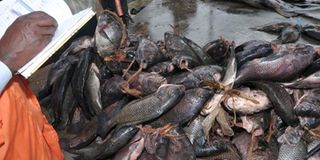Illegal fishing cuts Nile perch, Tilapia quantities

A trader takes stock of his fish catch. Decline in Nile perch and Tilapia fish quantities has been attributed to the use of illegal fishing methods and trading in immature fish. File photo
Kampala- Quantities of Nile perch and Tilapia fish species are declining due to rampant illegal fishing and trading in immature fish, the Ministry of Agriculture, Animal Industries and Fisheries has revealed.
In a statement issued by the ministry yesterday, the fisheries sector is being threatened mainly by the use of illegal fishing gears like undersized nets, beach seines, cast nets and prohibited fishing methods.
Increased costs
“As a result of the illegalities, the cost of fishing compared to the gains a fisherman receives has increased. Some fish factories are threatened with closure due to lack of raw material which affects national income in terms of tax revenues to government,” said Mr Jackson Wadanya, the commissioner in charge of Fisheries Resource management and development.
He revealed that the ministry has finalised plans to establish an agriculture/fisheries police section to strengthen monitoring, control and surveillance on all water bodies to guard the country’s second most exported commodity.
According to Mr Wadanya, about 18,320 metric tonnes of fish worth $108.6 million was exported in the Financial Year 2012/13 as a result of the recovery resulting from strong enforcement for the last two years.
Mr Wadanya’s remarks came on World Fisheries Day, which is celebrated every November 21 to highlight the importance of the world’s waterways and fisheries to human lives.
According to Mr Wadanya, the sector provides opportunities with over 250 fish species available in the five major lakes and 160 minor lakes and dams that are economically-important for trade and food.
“Uganda’s potential for aquaculture is high and this can be used to close the gap in the deficiency of raw materials for fish export and consumption demand and there is market for fish within the region,” he added
Challenges affecting the fisheries sector include limited public-private partnerships in the aquaculture sector, inadequate quality of fish seed and feed to boost aquaculture development and issues related to fish quality and handling.
Global demand
Reports indicate that more than 25 per cent of the world’s dietary protein is provided by fish with more than 100 million metric tonnes of fish consumed annually. It is reported that world over, annual fisheries exports are valued at $85-90 billion while fisheries and aquaculture employ 43 million individuals.




